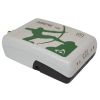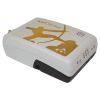Eos Arrow Lite GPS Receiver
The Eos Arrow Lite is a high-accuracy GPS receiver for smartphones, tablets, or notebook computers.
Features
- 100% Android, iOS, Windows compatible
- 60cm real-time accuracy using free SBAS
- Supports Esri and other Mobile GIS software
- Free ground shipping
- Expedited repair and warranty service
- Lifetime technical support
- More
Work Where Other Receivers Can’t
The Arrow Lite was explicitly designed with GIS users in mind. It squeezes more accuracy from GPS SBAS corrections than any other receiver in the world. With its patented technology, use the Arrow Lite under trees, around buildings and in rugged terrain where other receivers will fail to deliver. No post-processing is required.
High-Accuracy GPS Receiver
The Arrow Lite is designed specifically to use with various mobile devices, including smartphones, tablets or notebook computers. The Arrow Lite incorporates rock-solid, wireless Bluetooth technology that works with Android, iOS or Windows devices, making it obsolete-proof.
Choice of Mobile GIS Software
The Arrow Lite feeds 1cm RTK accuracy to every app on Android or iOS device, including Google or Apple maps. Esri Collector/ArcPad/ArcMobile, Fulcrum, AmigoCloud, TerraFlex, MapItFast, GeoJot, iCMTGIS, the Arrow 200 works seamlessly with all of them and many more mapping apps.
Real-time, Worldwide Accuracy
The Arrow Lite uses the free GPS SBAS corrections available in each geographical region: WAAS in North America, EGNOS in Europe and North Africa, GAGAN in India, and MSAS in Japan to provide 60cm real-time accuracy. For South America, Australia and Central and South Africa, where free SBAS is not available, Eos has partnered with OmniSTAR to offer real-time, sub-meter accuracy.
- (1) Arrow Lite receiver with Arrow Smart Battery Pack
- (1) L1 GPS Precision Antenna
- (2) Antenna Cables
- (1) Soft hat for Antenna
- (1) Nylon Carrying Case (belt clip & shoulder strap)
- (1) 12V International Power Supply for Arrow Smart Battery
- (1) USB Data Cable
In The News
Eos Arrow receivers give GIS pros real-time data, solid connectability
For pros working in mapping, surveying and other GIS fields, quick, precise data are a must. And the key to getting those data is getting the right receiver. As a result, many turn to high-accuracy, multi-constellation receivers like the Arrow series built by Eos Positioning Systems. The series includes the Eos Arrow Lite GPS Receiver, Eos Arrow 100 GNSS Receiver and Eos Arrow 200 L1/L2 GNSS Receiver. The receivers are popular for many reasons: They have the flexibility to use multiple satellite constellations, offer real-time data transmission capability and can connect to any device via Bluetooth. The Arrow receivers use the United States’ GPS constellation of satellites, but they can just as easily link up with Russia’s GLONASS, China’s Beidou and Europe’s Galileo.
Read MoreFrom Paddles to Phytoplankton: Studying Vermont’s Wildest Lakes
For six months of the year, Rachel Cray, a third-year PhD student at the Vermont Limnology Laboratory at the University of Vermont, lives between a microscope and her laptop, running data. For the other six months, she is hiking and canoeing four of Vermont’s lakes, collecting bi-weekly water samples. Cray studies algal phenology across four lakes in Vermont, US, that have low anthropogenic stress—or in other words, are very remote. Funded by the National Science Foundation Career Award to Dr. Mindy Morales, the lakes Cray researches part of the Vermont Sentinel Lakes Program, which studies 13 lakes in the area and, in turn, feeds into the Regional Monitoring Network, which operates in the Northeast and Midwest US.
Read MoreReimagining Water Filtration: How Monitoring and Science Enhance FloWater Filtration Systems
Over 50% of Americans think their tap water is unsafe , according to the Environmental Working Group (EWG). Other recent surveys have found that number to be as high as 70% of persons surveyed. Whether due to increased public awareness of water quality issues or confusion about how municipal water sources are regulated, there is a clear distrust of tap water in the United States. According to industry expert Rich Razgaitis, CEO and co-founder of the water purification company FloWater, this issue creates a damaging cycle. Razgaitis explained that the health and environmental problems associated with contaminated water aren’t the only issues. As people become increasingly aware that some tap water is unsafe, they resort to bottled water.
Read More







































